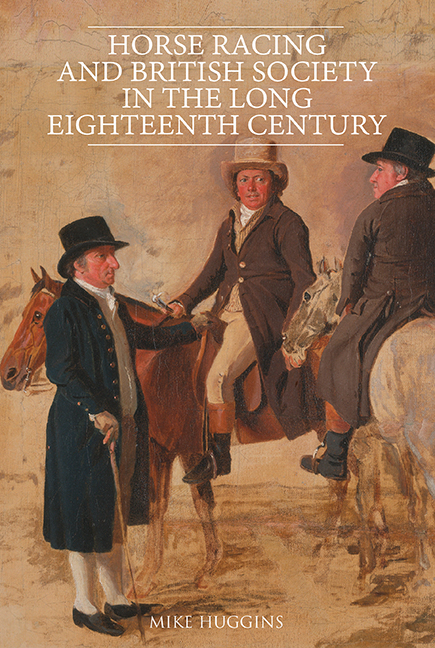Book contents
- Frontmatter
- Contents
- List of Illustrations
- List of Tables
- Acknowledgements
- Further Matter
- Introduction: Setting the Scene
- 1 The ‘Race Week’ in British Social Life
- 2 The Secret World of Wagering
- 3 Horse Racing and British Politics
- 4 Racing and its Rules
- 5 Running the Race Meeting
- 6 The Racehorse, its Ownership and Breeding
- 7 Vital Professionals: Jockeys, Grooms and Trainers
- Conclusion
- Bibliography
- Index
Introduction: Setting the Scene
Published online by Cambridge University Press: 28 June 2018
- Frontmatter
- Contents
- List of Illustrations
- List of Tables
- Acknowledgements
- Further Matter
- Introduction: Setting the Scene
- 1 The ‘Race Week’ in British Social Life
- 2 The Secret World of Wagering
- 3 Horse Racing and British Politics
- 4 Racing and its Rules
- 5 Running the Race Meeting
- 6 The Racehorse, its Ownership and Breeding
- 7 Vital Professionals: Jockeys, Grooms and Trainers
- Conclusion
- Bibliography
- Index
Summary
THE ‘long eighteenth century’ from the restoration of Charles II to the end of the Napoleonic wars was a key period for British horse racing. Commercial leisure was growing in importance. In a country where life was usually lived in close proximity to horses, and horse ownership was widespread, horse racing became a very culturally significant leisure form. It was by far the best-organized, best-supported, most high-status, best-publicized and distinctive field of practice and sporting activity of the age. It had a major contemporary impact as a social phenomenon, was deeply embedded in contemporary societal norms and values, and helped shape modern racing. It provides a very convenient lens through which to view eighteenth-century society, yet remains a surprisingly overlooked aspect of early modern British cultural life in standard histories of the period.
A substantial social, cultural and economic historiographical gap remains to be filled on racing's accelerated growth during this time. This study redresses the imbalance in historical research by providing an innovative analysis set in the broader contexts of leisure consumption and British culture. As Jeremy Black stresses, eighteenth-century culture was complex and ambivalent, and racing was no exception.
British wealth was increasing rapidly in real terms, the population was rising, and growth in disposable income higher up the social scale encouraged conspicuous leisure spending. This helped involvement in racing as owner, gambler or spectator to grow in cultural and social popularity. Horse racing's growing commercial thrust ensured more regular meetings, with prize money increasingly raised on a collective basis.
By 1809 the Morning Chronicle could describe horse racing as the British people's ‘ancient, authorized and national sport’, and this was an increasingly commonly held view. Thoroughbred breeding had become a matter of national pride and was slowly gaining interest overseas. Though regarded suspiciously by nonconformists, racing brought together the elite and middling orders in shared leisure interest. The sport was socially and culturally constructed. It was shaped by racehorse owners and breeders advancing their own glory and political influence; by gamblers exploiting the less-experienced; and by urban individuals and interest groups deciding to hold a race meeting to bring in trade and making decisions about its nature.
Horse racing was a cultural artefact and, like all eighteenth-century sports, possessed its own specific meanings, contexts, organization, rules and rituals. It affected and was influenced by broader political, economic, social and cultural trends.
- Type
- Chapter
- Information
- Publisher: Boydell & BrewerPrint publication year: 2018



